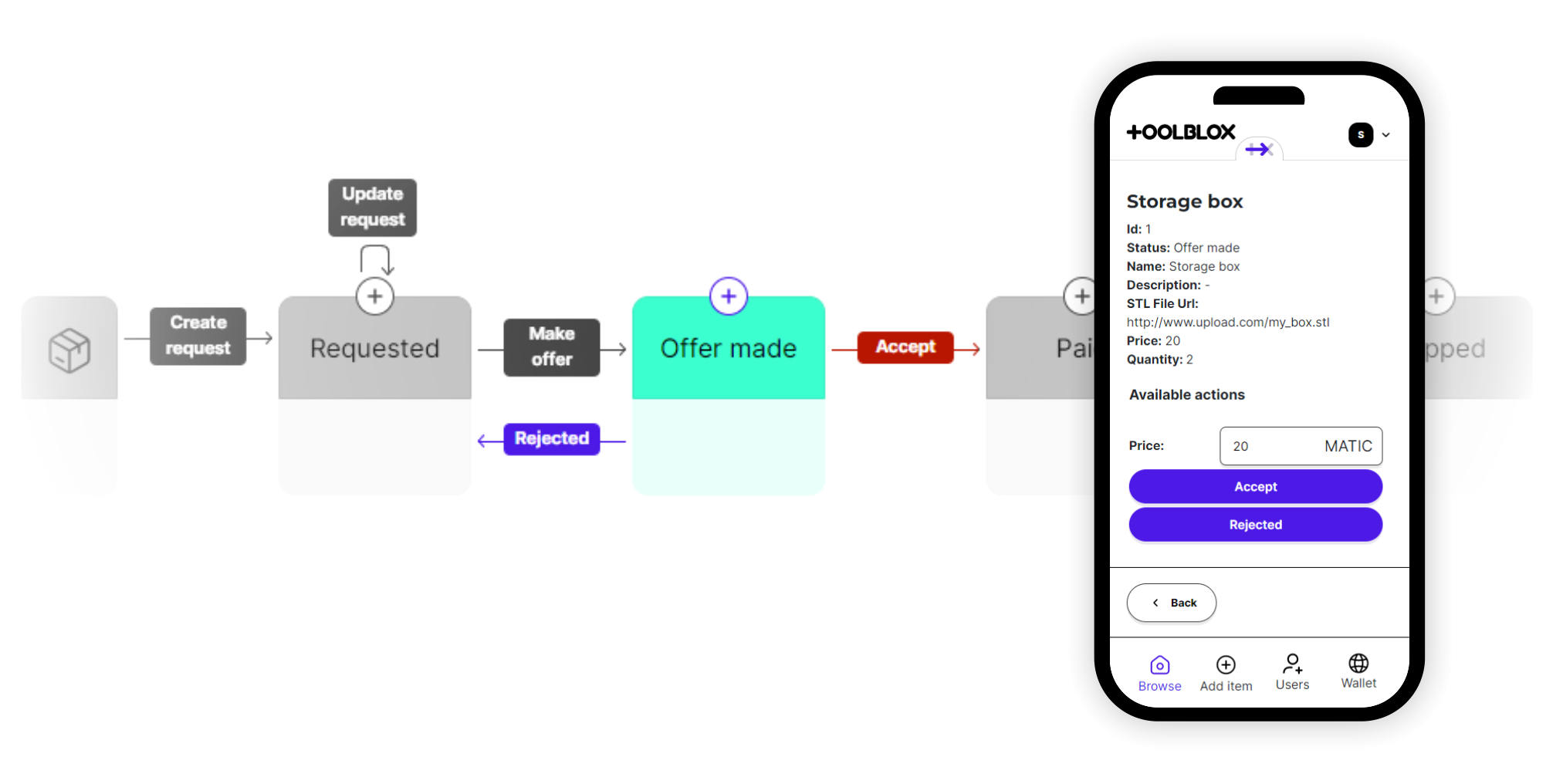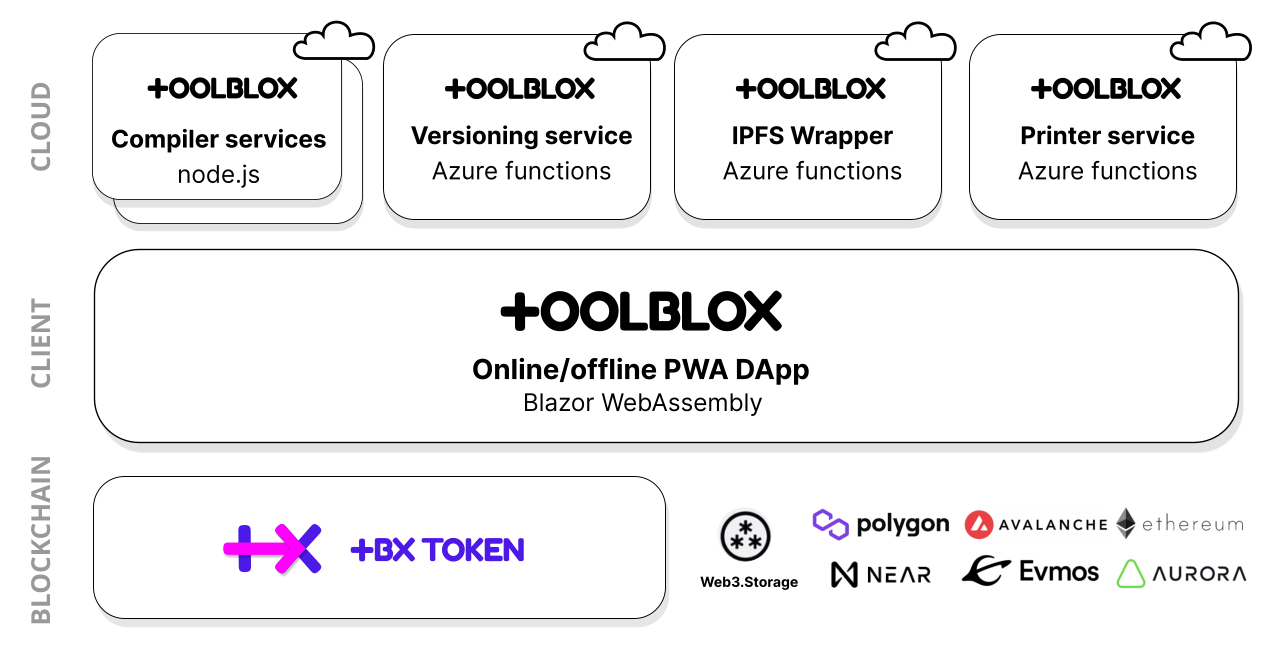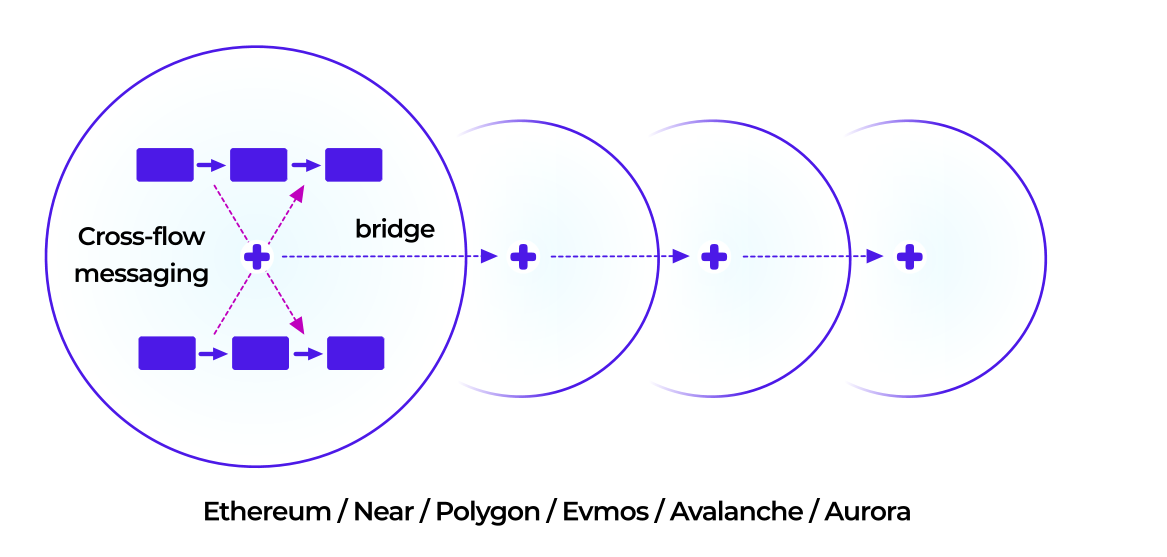Toolblox whitepaper
Our vision
Our vision is to make the benefits of blockchain technology accessible to everyone and every business globally.
Our mission
Our mission is to provide the tools and resources necessary to create interconnected, self-executing smart contracts and on-chain business networks. These networks allow partners to effectively exchange value and act on a single source of truth, while also enabling end-users to participate through decentralized applications (DApps).
Introduction
The problem
- Custom smart contract development is costly and lengthy requiring specialized know-how (smart-contract development, auditing etc) and lengthy (average projects taking 6-12 months)
- Smart contract templates available today are very complex and also expensive to set-up. Often times it is only the provider who can be commissioned to set it up. Futhermore, every change to a complex template would require an expensive re-audit.
- Smart contract auditing is costly and difficult. The process involves finding auditors and managing the process.
- Public blockchains while great for decentralization, provide little privacy for many business usecases.
The solution

- Simplify with our full-stack approach. To solve these problems, we offer a simple, no-code smart contract maker with state-based workflow and the option to generate a decentralized application (DApp).
- AI-ready Toolblox uses a human-readable representation of a smart-contract workflow (Toolblox Spec) that can also be used to facilitate communication with AI systems. For example to gain the ability to generate workflows from written paper contracts.
- Auditable Every smart contract created with Toolblox will use audited base contracts. Furthermore, every smart contract will be composed of pre-verified components. This makes the smart contract straightforward and cost-effective to audit.
- Deployment to any blockchain Toolblox can assemble a smart contract for any (pre-determined) blockchain in their native language.
- Business integration Toolblox offers integration scenarios specially catered to SMEs and business automation use-cases.
- On-chain business networks Self-executing smart contracts allow for automatic action to be taken as soon as certain thresholds or business conditions are met, reducing both costs and time. Additionally, our smart contract workflows can reference each other and trigger events in other smart contracts, helping to save on integration costs and enabling the creation of interconnected business process networks.
- Data ownership The generated smart contracts are deployed using customers wallet so thet are under full ownership of the customer: this includes the workflow logic and any data it contains.
Toolblox
Toolblox allows to manage full lifecycle of business objects (physical assets, digital content or workflow of documents) across companies, DAOs and different stakeholders using public blockchains.

- Toolblox application allows companies to quickly and easily create their presence on the blockchain. With our visual, no-code Contract Maker, users can build a smart-contract and deploy it as a usable application without any coding knowledge. Our state-machine based workflow is a great fit for smart-contract visualization.
- Workflow in Toolblox is a sequence of states with transitions between states. Each workflow defines as well an object and object attributes. Each transition (from state to state) defines additional automation which can be perfomed during that transition such as: attributes to change, other workflows to call, expressions to evaluate, payments to execute.
- In addition to building custom smart contracts, Toolblox also generates a DApp out of the box for easy sharing with end users and business partners. For more complex user interfaces and customization, we also offer a DApp Maker that enables users to design decentralized applications without any code.
- Our proposed TIX token acts as a service-locator enabling cross-workflow calls and, ultimately, the creation of on-chain business networks.
Examples
Some examples of workflows that can be built with Toolblox include:
- A project management system with states for "active," "cancelled," and "waiting for feedback," and transitions for "amend," "pay," "create," "agree," and "update."
- A document management system with states for "draft," "review," and "approved," and transitions for "edit," "submit for review," and "approve."
- An offer or proposal system with states for "pending," "accepted," and "rejected," and transitions for "create," "accept," and "reject."
Business model
Creating workflows and deploying to any blockchain is free. Toolblox provides complementary cloud services for versioning and workflow management. Furthermore, we monetize the usage of the generated user interface on volume basis. Additionally, the TIX ERC20 is used for more advanced use-cases such as cross-workflow communication operates on a fee-based mechanism.
Target customer
Our platform is suitable for decentralized autonomous organizations looking to manage custom workflows and projects, supply chain and commodities industries, and small and micro businesses. Toolblox can be used as a digitalization tool, rapid prototyping tool, development kickstarter, or as a backbone to an existing product.
Timeline and milestones
- 2022 Q1: Prototype
- 2022 Q1: Winner ‘First Place’ and ‘Best use of Technology’ at Near Metabuild II hackathon
- 2022 Q2-Q4: Market research and product development
- 2022 Q3: Release of Contract Maker
- 2022 Q4: Winner First place Tooling/Infrastructure at Polygon BUIDL IT hackathon
- 2022 Q4: Release of DApp Maker
- 2022 Q4: Release of ADA (Autonomous Decentralized Accountant) blockchain invoice generator
- 2022 Q4: Launch of Toolblox Academy learning resource
- 2024
- 2023 Q1: Public beta test in partnership with LNC
- 2023 Q1: DApp Widgets for Web2 integration
- 2023 Q2: AI assistant alpha release
- 2023 Q2: Token Maker launch
- 2023 Q3: Public launch with Subscriptions
- 2023 Q3: Audit of Toolblox base contract
- 2023 Q3: Asset Dashboard launch
- 2023 Q4: Audit marketplace launch
- 2023 Q4: Patent filed
- 2024
- 2024 Q1: Gasless transactions and Social login launch
Roadmap
- 2024 Q1: One-time payments using the Toolblox Token (TIX)
- 2024 Q1: Toolblox Contract API launch
- 2024 Q3: Private Contracts (ZK) launch
- 2024 Q3: IDO
- 2024 Q4: Toolblox Upgrade and Migration tool launch
Toolblox Architecture
The architecture is driven by three main ideas: decentralization, extensibility and standardization.
Decentralization
Toolblox user interface is a Progressive Web Application (PWA). While usable with a web browser it can be obtained and run without a web server. The idea is that creating workflows should be possible without any backend connectivity to Toolblox cloud services in order to eliminate central points of failure. While the app is available at app.toolblox.net, it could as well be downloadable from IPFS or by other means and installed as a standalone application. This ensures resilience and anonymity if so desired by the user. PWA is part of stage 1 developments and is currently up and running.
Extensibility
Toolblox offers some free and some paid services out of the box, such as code printer, IPFS upload, versioning services, compilators etc. User should be able to decouple these services and use either local alternatives (e.g. command line compiler) or other services (such as straight IPFS connection with custom API key) instead. This ensures decentralization and gives the user options to pick-and-choose providers based on particular preference. This advanced extensibility is expected to be delivered in stage 2.
Standardization
One of the key points in fulfilling our mission is creating business networks through interconnected workflows. This means
- Workflows need to be able to reference and call each other.
- There needs to be a common language to describe these on-chain business processes. Workflows might reside in different incompatible blockchains and partners have to exchange information about each others workflows using chat, email or written contracts.
Toolblox Spec is a textual representation of Toolblox workflow. It is human readable, enables import/export and can be used for AI integrations.
TIX Token implements a service-locator pattern which allows workflows to register themselves and to call other registered workflows.
Components
- PWA DApp
- Cloud services
- Versioning service
- Blockchain compiler services
- IPFS wrapper service
- Printer service
- TIX Token
- TIX Token Bridge

PWA DApp
Main application is usable online or offline (using local browser storage). It contains the following primary tools:
- Contract Maker which allow to build workflows, deploy with a single click to selected blockchain and use the auto-generated user interface. In beta now.
- DApp Maker which allows to create custom applications which have their own theme and connect potentially to multiple workflows. In alpha as of now.
- Data migrator allows to upgrade workflows and bring over object data without any coding. Not yet available.
- Browser to explore existing workflows.
TIX Token

TIX token today is an ERC20 utility token with added functionality to store up-to-date workflow locations in order to retrieve them for cross-flow messaging. Cross-workflow communication is a prerequisite for creating business networks on chain.
In shorter term, TIX token will be used to unlock certain features like deployments, blockchain programming languages, new blockchains, hosting and AI credits on the platform. Furthermore, TIX will act as a governance token and be used for voting.
Long term goal of TIX token is to democratize blockchain development. Toolblox today is an automated system that creates smart contracts out of pre-validated/audited smart contract modules. The role of TIX token will be to facilitate the creation of a living blockchain development ecosystem around this innovation and to incentivese adding new modules, updates, audits and the ability to use these modules in new smart contracts. The vision is to create a value network that makes creating blockchain-based applications easier and faster.
TIX technical details
The token implements an IServiceLocator interface that gives it a getService and registerService smart contract utility methods. The registration method can be used when deploying new smart contracts, while conversely, the get method can be used during smart contract execution to find other, dependent smart contracts. Similar to how routing services or name services work.